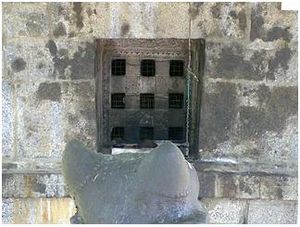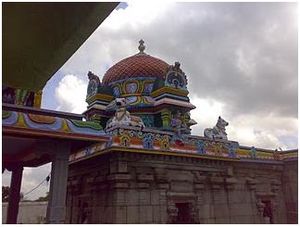Aathur Sri Muktheeswarar
Aathur village is situated 5 kms off the Chengalpattu Bridge on the west of GST Road. Aathur has a beautiful temple belonging to Chozha period.
The main deity here is Sri Muktheeswarar and Goddess Sri Dharmasamvardhani Ambaal, also called Aram Valartha Naayagi (அறம் வளர்த்த நாயகி). This wonderful temple has Lord Shiva in the form of Shiva Lingam facing east. The unique feature of this Lingam is, a thin ray of line separates the top portion (Baanam) of Lingam into two equal halves vertically. It is said that such Lingam is very rare to see and it represents the Ardhanaareeswarar (Shiva & Shakthi in equal halves) form of Lord Shiva.
Sri Vinayagar has a separate shrine in the temple’s outer praakaaram and is facing east. There are many stone inscriptions found all along the walls of the temple. According to the inscriptions this Vinayagar was installed by a local villager in this temple, during Chozha reign. The inscriptions also reveal that the funds generated from this temple were donated to build one of the Gopurams of Chidambaram Sri Natarajar Temple. It thus shows the prosperity of this temple in those days.
This temple lies on the banks of the river Palar, also called Ksheera Nadhi which serves as the Theertham for this temple. It is also said that as the temple lies on the river banks of Palar, the place was originally known as ‘Aatru Oor’ (Aaru means, river in Thamizh) which later corrupted to become Aathur. This temple has beautiful praakaarams. The outer praakaram has Sri Vinayagar, Sri Dhakshinamurthy, Sri Brahma and Sri Durgai around the sanctum. Just near Sri Dhakshinamurthy shrine, a small underway is seen, which is kept closed using an asbestos sheet. There is a small room under the ground level which is said to be the hiding place during the times of war.
Sri Valli Devasena Samedha Sri Shanmugar has a separate shrine on the praakaaram. The idol of Sri Shanmugar is yet to get Ashtabandhanam done. The idol is wonderfully sculpted with Lord Shanmugar with 6 faces, 12 arms holding weapons and seated majestically on an aesthetic peacock which is holding the snake in its beak. All the details of this idol along with its base is made of single stone and is just kept in the shrine without fixing it (Ashtabandhanam) to the floor. The idol is made in such a way that it aptly balances itself firmly on the ground.
On the North West side of the praakaaram Sri Jyeshta Devi is seen facing east. Sri Jyeshta is elder to Sri Lakshmi as she evolved out prior to Sri Lakshmi during the churning of the mighty ocean, Ksheera Saagaram (Paarkadal). It is said that Sri Jyeshta Devi was one of the main deities for the then Chozha rulers. A beautiful Nandhi is seen facing west towards the Lord. There is a window beautifully sculpted on stone in front of Sri Nandhigeswarar, having 9 holes to it. It is called Navadhwaram in Sanskrit. The northern side of the praakaaram has the shrine for Ambaal Sri Dharmasamvardhani. Sri Ambaal is so beautiful and charming and is facing south.
At the north eastern side of the praakaaram, about 4 Lingams are kept in a separate mandapam which were found during excavation. Out of 4 Lingams, 2 are Baana Lingams, without the Aavudaiyaar (base). It is said that, this temple as 8 Shivalingam shrines (Ashta Lingam) around it on all 8 directions, like Thiruvannaamalai temple. But the people were able to locate only a few till now. There is a stone marking on one of the walls of the temple, mentioning that the Kumbhabhishekam (Consecration) was held last on 30.08.1917.
The Theertham for this temple is Ksheera Theertham (Palar river) and there are 2 Sthala Virukshams for this temple, Vilvam and Maa Maram (Mango tree). This mango tree has a very unique quality. This tree branches into two from the base and the fruits formed from each half of the tree has different tastes. It is said, as Lord Shiva here is in the form of Ardhanaareeswarar the tree too naturally gives fruits with 2 different tastes, symbolising the dual form of Lord Shiva.
Pradhosham and Maha Sivarathri are celebrated in a grand manner in this temple. Like Thiruvannamalai temple, this is one of the temples which conduct 6 times Pooja during Sivarathri. This temple has been in a dilapidated condition and the local youths have formed a trust called ‘Srimath Muktheeswarar Nithya Poojai Arakkattalai’ to help bring back the originality of the temple and to conduct Poojas everyday.
Contact Info[edit]
Those willing to visit or help the temple shall contact Sri Ananthasayanan (+91 98422 89081) or Sri Rishikesh (+91 97103 46703), 'Athur Srimath Muktheeswarar Nithya Poojai Arakkattalai', Reddy Street, Aathur Village and Post, Kanchipuram District – 603 101.
The temple which will surely be admired by temple lovers

















